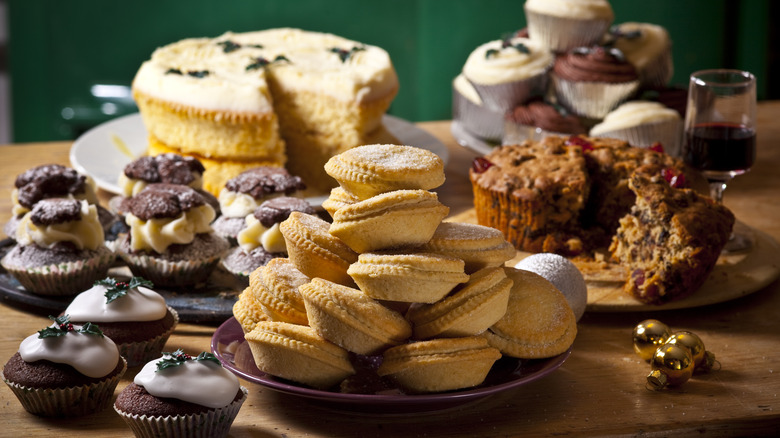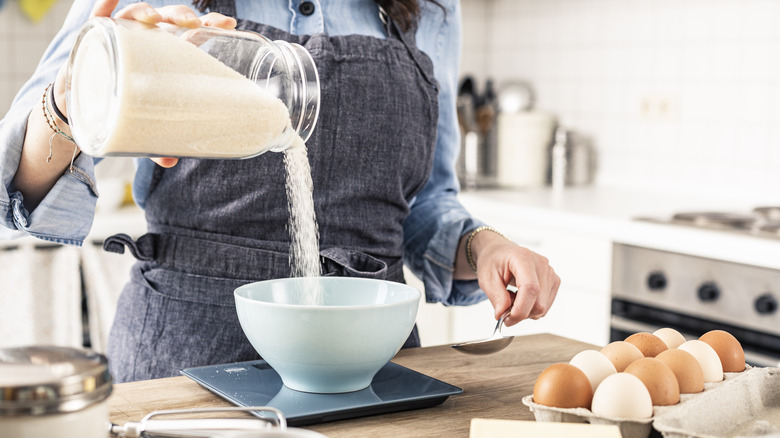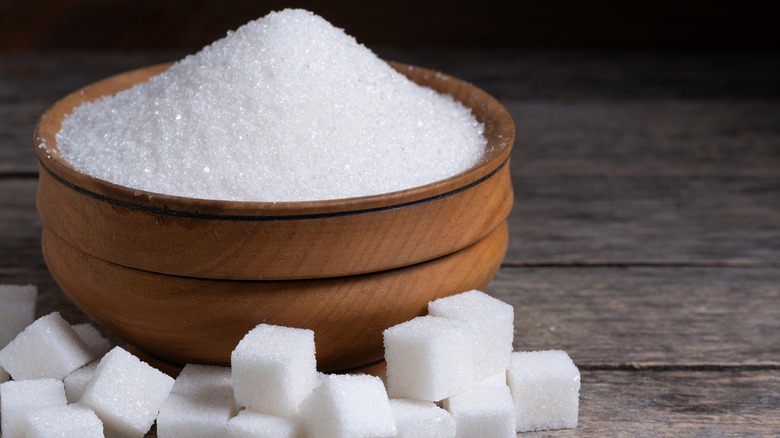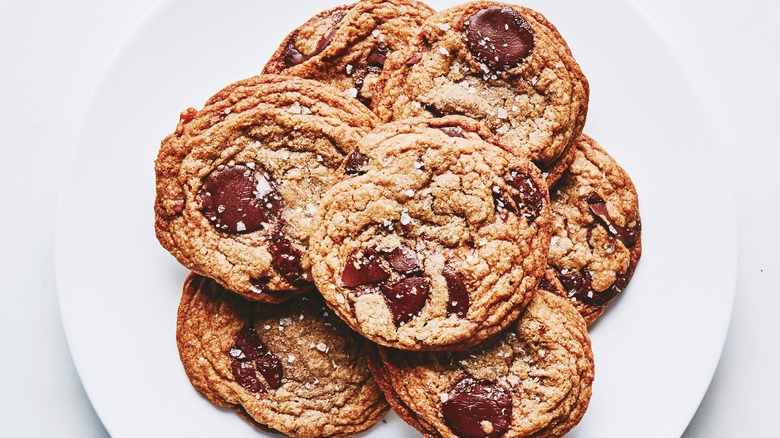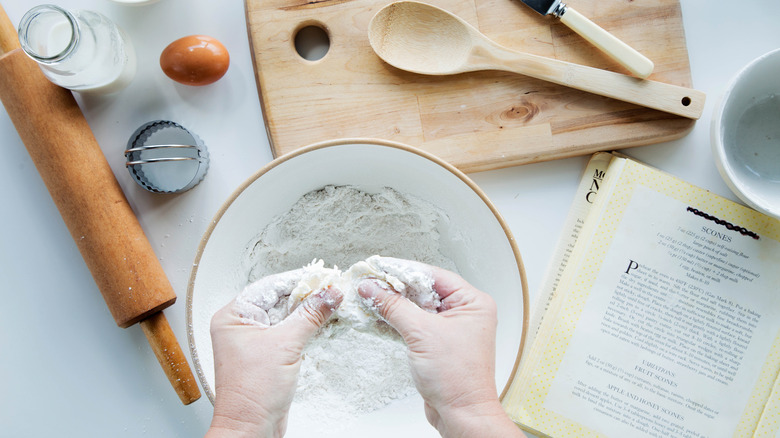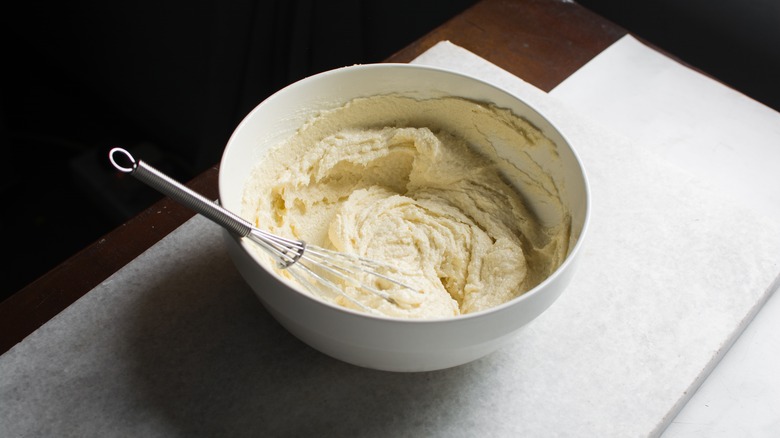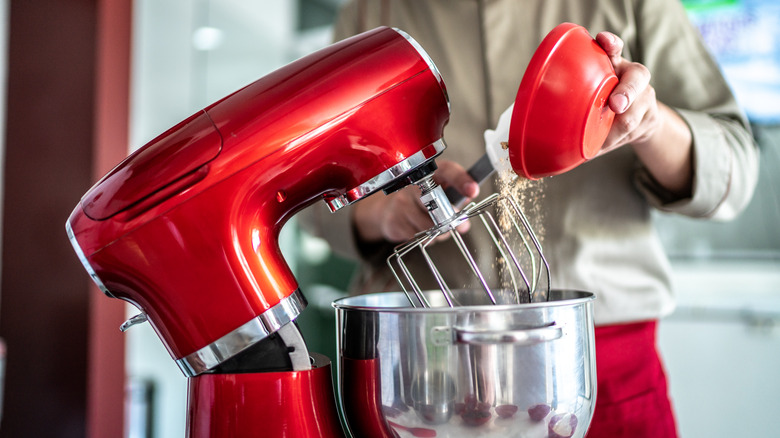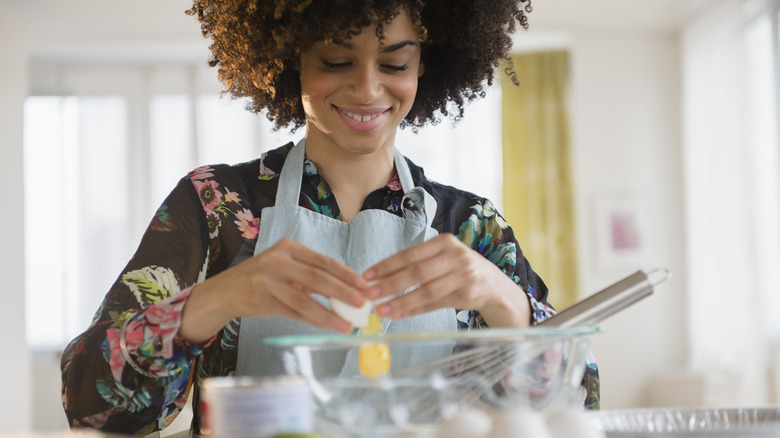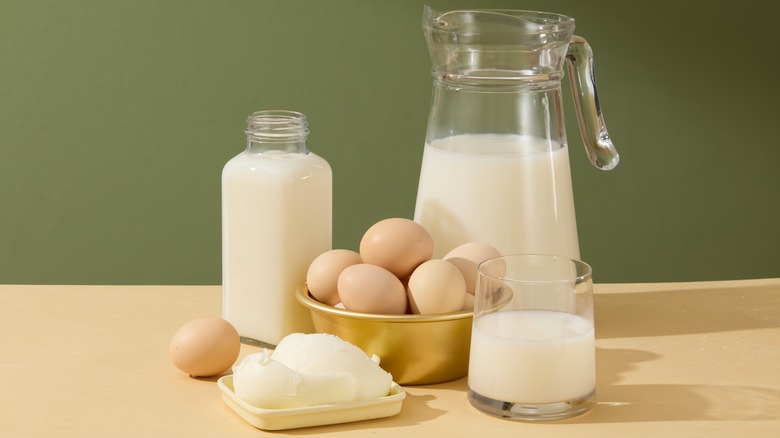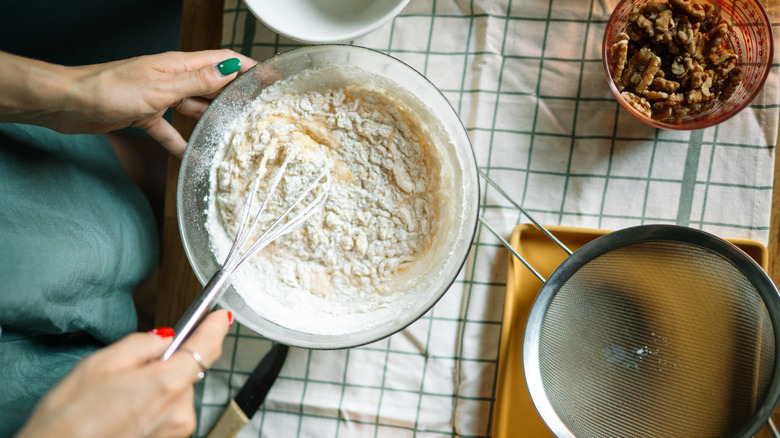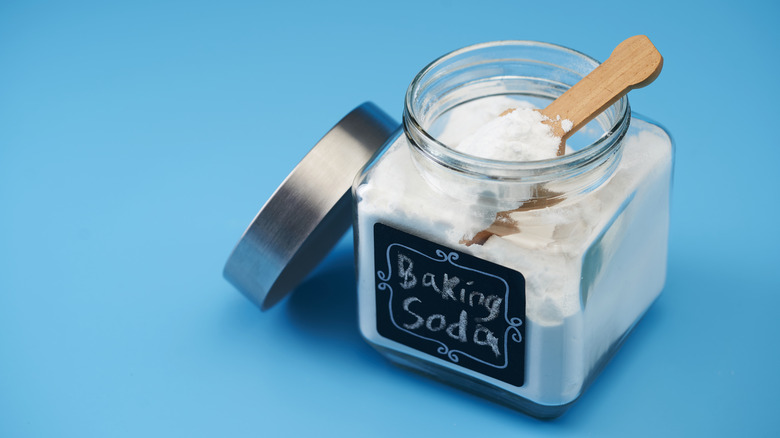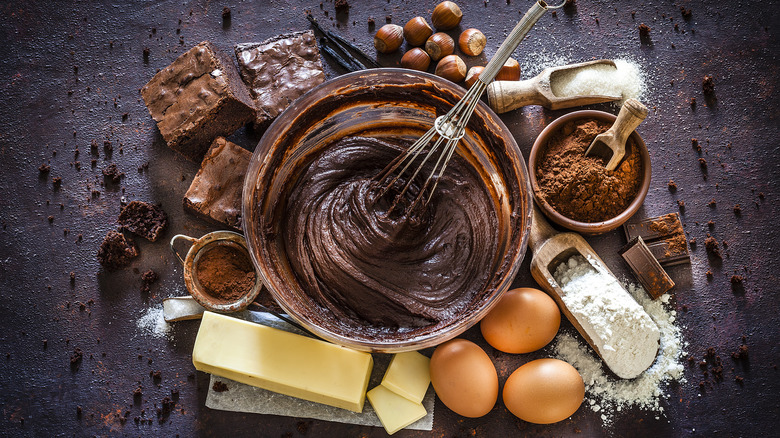False Facts About Baking Desserts You Thought Were True, According To Baking Pros
So many people love baking desserts (or at least love eating the food they bake). But it's an area of cooking that's surrounded by myths and misconceptions. Whether you're a beginner or have been baking for years, you might have heard advice that isn't true. There are things that people present as fact about baking that are false. That's why we're here to bust common dessert-baking myths and clear up confusion about ingredients, techniques, and equipment.
I'm an experienced baker, recipe developer, and food writer, but I still wanted to get the facts from some true experts. I talked to three people in the know about baking, including trained pastry chefs and food bloggers. They shared their knowledge and helped separate fact from fiction. You might be surprised to learn that some things you thought were true about baking are actually false. For example, did you know that you don't always need to follow a recipe exactly? Or that sugar does more than just make things sweet?
We're here to give you a better understanding of what really matters in baking. You'll learn which rules you should follow and which ones you can bend a little. This knowledge will help you become a better baker and have more fun in the kitchen. Here are some false facts about baking desserts you thought were true, according to baking pros. The payoff will be even more delicious desserts and sweet bakes.
False: Cups are the best tool for measuring ingredients
If you're in the U.S., you're probably used to getting out your trusty measuring cups every time you bake dessert. This might have led you to believe that cups are the best tools for measuring ingredients. However, you'll have better and more consistent results using a kitchen scale. In fact, it's one tool iconic chef and cookbook author Samin Nosrat can't do without.
"Using a kitchen scale is way more accurate than cup measurements," food blogger and recipe developer Ella Gilbert of Alpine Ella tells us. "When recipes are in metric weights, it's a lot easier for anyone to get the same results if they're following the recipe."
But why does it make a difference? "Baking is a science, and slight variations in measurements can affect the final product significantly," says Emily Laurae Carter, a recipe developer and trained pastry chef. "For instance, the way you scoop flour can lead to different amounts, but if you weigh it, you'll get consistent results every time."
How you measure impacts the outcome when you're baking. So rather than getting different results depending on whether you pour or scoop your flour, you know you're being precise when you use kitchen scales. Cups might seem like the most quick and convenient way to measure, but actually scales are easy to use and just as simple once you get used to them. It might be time to ditch the cups and make better baked goods.
False: The sugar in desserts is just for sweetness
Yes, sugar adds sweetness to desserts but many people think that's all it does, and this just isn't true. Sugar can play a range of roles in desserts, affecting the texture and the flavor. To use it to its best advantage, it's good to know everything that it offers.
"Since sugar is hygroscopic [it attracts and holds moisture], it helps your cookies, muffins, and other treats stay moist instead of drying out," explains recipe developer Ella Gilbert. "In cookies, sugar also plays a big role in browning and affects the texture," she tells us. "Add more sugar, and you'll get a crispy cookie; add less, and you'll get a soft and chewy one."
Trained pastry chef and instructor Emily Laurae Carter also stresses the importance of sugar in desserts beyond just sweetness. She remarks that it helps with various functions, including the structure, texture, and color of baked goods. "In cakes and cookies, sugar helps to trap air during the creaming process, which leads to a light and tender crumb," she says. "It also caramelizes during baking, adding color and depth of flavor."
The type of sugar you use is important, too, so don't just switch one out for the other and expect the same results. For instance, "brown sugar has molasses, which changes the flavor and also affects the structure of whatever you're baking," Gilbert adds.
False: You don't need salt in baked goods
Salt is a savory ingredient, so you might think it's unimportant in desserts. If you see it on an ingredient list, maybe you even decide to ignore it. But a common misconception when people are baking sweet recipes is that salt doesn't matter. It actually plays a bigger role than you might imagine, so don't ignore it.
"Salt does play a role in baking sweet recipes even though it might seem counterintuitive, since salt is typically associated with savory foods," says Kari Cota, the executive pastry chef at Kimpton Alma. "Some key roles for salt are flavor enhancement, improving texture, regulating yeast activity, and strengthening batters."
"Even in small amounts, it enhances the flavors of other ingredients and balances the sweetness, making the overall taste more complex and satisfying," notes recipe developer Emily Laurae Carter. Food blogger Ella Gilbert agrees that "you need to add salt to sweet recipes to enhance the sweet flavor — it's so key to baking."
If you've ever enjoyed salted caramel or a chocolate chip cookie with delicate flakes of sea salt sprinkled on top, you'll understand. In some recipes, you want a slight amount of saltiness to come through. In others, you aren't meant to taste the salt at all, it just enhances the other flavors without announcing itself. Stick to the type of salt and quantity of salt in the recipe, as both of these factors make a difference.
False: You should always trust a recipe and follow it exactly
People often say that baking is a science, and we're not debating that. Baking involves plenty of scientific principles and chemical reactions. Without these, you wouldn't get a delicate crumb in cakes or the complex flavor that comes with a golden brown cookie. However, this doesn't mean you always have to follow a recipe to the letter. In some cases, you should follow your instincts and use your existing knowledge.
"Recipes are a great guide, especially when you're trying something new, but there's definitely a time and place to trust your senses," says pastry chef and recipe writer Emily Laurae Carter. "Ovens can vary, ingredients can behave differently depending on your environment, and sometimes the visual cues are more reliable than a set time or temperature," she explains. There are always some occasions when you should use your senses and what you already know about baking. "If a cake looks golden and a toothpick comes out clean but the timer hasn't gone off yet, it's probably done," Laurae Carter remarks. "Experience and intuition are invaluable tools in the kitchen," she adds.
However, it's not just that ingredients, equipment, and environmental factors can influence results, some recipes are just less reliable than others. If you read through a recipe and the ratio of ingredients or the method seems strange to you, consider whether it's from a reputable source. If it is, the recipe might just be using techniques you're not aware of; otherwise, look for an alternative recipe.
False: The order of the steps in a dessert recipe doesn't matter as long as you get everything done
There are mistakes everyone makes when baking cakes and desserts. Some of them are simple errors, but others come down to misinformation. For instance, you might have heard that it doesn't matter what order you follow the steps in a recipe. That if you get all the ingredients in the dough or batter by the end of it, the results will be the same. But this is a false that people need to stop perpetuating.
"Some ingredients need to be combined in a specific order to achieve the right texture and flavor," pastry chef Kari Cota tells us. "For example, creaming butter and sugar together before adding eggs helps to create a light and airy texture."
"There are different ways to make a cake, and each method gives you different results," says Ella Gilbert of food blog Alpine Ella. Like Cota, she mentions the importance of creaming. However, she also mentions blended recipes "where everything gets mixed together at once" and the reverse creaming technique, where butter and dry ingredients are mixed first, followed by the wet ingredients. "These methods lead to different textures, so following the order of steps is important," Gilbert explains.
False: You need lots of special equipment to bake well
"Another common myth is that you need fancy equipment to bake well," says recipe developer and trained pastry chef Emily Laurae Carter. However, "sometimes, simple tools and good ingredients are all you need," she tells us. So, if you've been stressing because you don't have a KitchenAid mixer or the best cake pans money can buy, don't sweat it.
There are all kinds of dessert and baking hacks out there for anyone who wants to go fully DIY. For instance, you can make your own piping bag with a freezer bag or use a glass bottle as a rolling pin. People were baking dessert long before high-end, Instagrammable kitchen gadgets came into fashion, so you'll do fine with the basics.
A few simple items like mixing bowls, cake tins, and a reliable oven are all you really need. What matters most is understanding your ingredients and techniques. With practice and the right know-how, you can make all kinds of desserts with simple kitchen equipment. Your skills and knowledge are far more important than having the latest baking accessories.
False: Baking is an exact science and there's no room for creativity
Many people think baking is all about following recipes exactly, with no room for creativity. But this idea is actually a myth. While it's true that baking involves some science and precision, there's still plenty of space for you to be creative and make recipes your own.
"While it's true that baking relies on precise measurements and techniques, there's still plenty of space to play with flavors, textures, and presentations/garnishing," Emily Laurae Carter remarks. Once you understand the basic rules, you can start to experiment. For instance, you can often change up the spices or add new flavors to a recipe without ruining it. You might replace chocolate chips with nuts in a cookie recipe, or add lemon zest to a vanilla cake. Or you could try some clever ingredients that will elevate your baked goods, such as using browned butter in recipes or switching out vanilla extract for vanilla bean paste.
It's also okay to adjust ingredient amounts slightly. Maybe you want your cookies chewier or your cake denser. By tweaking the amount of butter, sugar, or eggs, you can change the texture of your baked goods. Even professional bakers don't always stick to recipes exactly. They use their knowledge and experience to make changes and improvements. As you bake more, you'll learn which parts of a recipe are important to follow closely and where you can be more flexible.
False: The temperature of your ingredients doesn't matter
People often think that the temperature of ingredients doesn't matter. That you can use chilled butter in a recipe that calls for room-temperature butter or that eggs and milk can go into a batter right out of the fridge. We get it, it doesn't seem like much of a difference, but it can greatly affect the end results.
"Not letting ingredients like butter and eggs come to room temperature can make it harder to achieve the desired texture in your baked goods," explains recipe creator Emily Laurae Carter. Ella Gilbert, recipe developer at Alpine Ella, backs this up. She says that using room-temperature ingredients — such as eggs, milk, and cream cheese — helps them mix together much more smoothly. "If your ingredients are cold, you can end up with a chunky mixture, which leads to dense cookies, lumpy cakes, or weird frosting," she notes.
One example Gilbert gives us is that when butter's too cold, sugar won't aerate it properly during the creaming stage. "The sugar crystals should create tiny air pockets in the butter, which makes the cake light and fluffy," she tells us. "If the butter is too cold, you'll end up with a dense, tough cake instead." It might be annoying when you're in a rush, but take the extra time needed to let the ingredients come to room temperature. The results you get will make it worthwhile.
False: It's hard to overmix batter
Some people think it's hard to overmix doughs and batters when making desserts. It's a common myth that there's enough sugar and fat in these kinds of recipes to prevent too much gluten from forming. However, it's way easier to overmix batter than you might think.
Overmixing batter is a common problem when baking desserts. It's easy to do because you might think more mixing means better results, but that's not always true. When you mix batter too much, you can create tough, chewy desserts instead of light, fluffy ones.
When you mix flour with liquid ingredients, it forms gluten. Gluten is a protein that gives structure to baked goods. A little gluten is good, but too much mixing will degas your baked goods, leaving them flat and tough. The other thing to watch out for is overmixing the eggs, which should be frothy and folded in with minimal stirring.
All our experts warned against overmixing as a common problem. According to Emily Laurae Carter, it produces "tough, dense baked goods." But, how do you keep from mixing your batter or dough too much? For cakes, muffins, and quick breads, you should mix just until the ingredients are combined. Once you don't see any more dry flour or large lumps, stop mixing. Pancakes and waffles are particularly easy to overmix. A few lumps in the batter are actually good. Cookie dough is a bit more forgiving, but you can still overmix it, so don't keep going once it has come together.
False: Baking powder and baking soda are interchangeable
Baking powder and baking soda — they're practically the same thing, right? Both are white powders that you add to baked goods to help make them rise. It stands to reason that you can easily switch one for the other. However, this is a common misconception that can lead to problems with your bakes.
"Baking powder and baking soda are not interchangeable," says Kari Cota, an executive pastry chef. "Baking soda requires an acid to activate while baking powder contains both an acid and a base," she explains. You might still be wondering if this actually makes a difference. It does. "Using them incorrectly can affect the rise and texture of your baked goods," Cota tells us.
If you only have one or the other, and it's not the same as the one the recipe calls for, don't worry. You can sub one for the other, but not like-for-like. If a recipe calls for 1 teaspoon of baking powder, you can replace it with ¼ teaspoon of baking powder, plus 1 teaspoon of lemon juice or white vinegar. Conversely, if a recipe calls for 1 tsp of baking soda, you can replace it with 3 teaspoons of baking powder.
False: You can substitute most ingredients and get similar results
When you're baking, each ingredient in a recipe plays a specific role, and changing one can affect the whole outcome. While you might think swapping ingredients is no big deal, it can make a big difference to your desserts. Kari Cota tells us that "substituting ingredients incorrectly" is a common mistake people make.
There's a good reason why this matters. Let's say a recipe calls for butter, but you use oil instead. This change can make your cookies spread too much or your cake too dense. "Each fat behaves differently and will affect the final product in unique ways," Emily Laurae Carter explains.
The same goes for sugar. Brown sugar and white sugar aren't exactly the same. Brown sugar has molasses, which adds moisture and a different flavor. If you swap one for the other, your dessert might turn out drier or sweeter than expected. You can't go around substituting different types of flour, either. All-purpose flour and cake flour have different protein levels, which affects how much gluten forms. This can change the texture of your baked goods.
This doesn't mean you can never make substitutions. Sometimes you can, but you need to understand how ingredients work together. It's best to follow recipes closely when you're new to baking and only make substitutions when you have the experience to anticipate how they'll affect your final bake.
